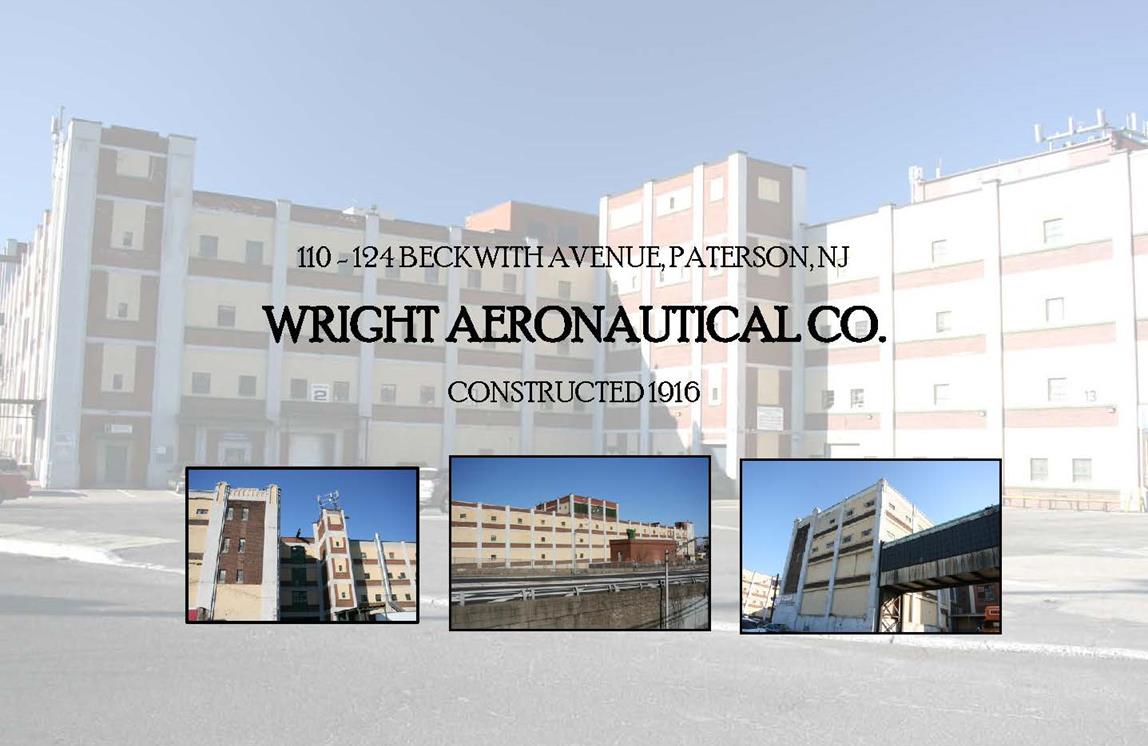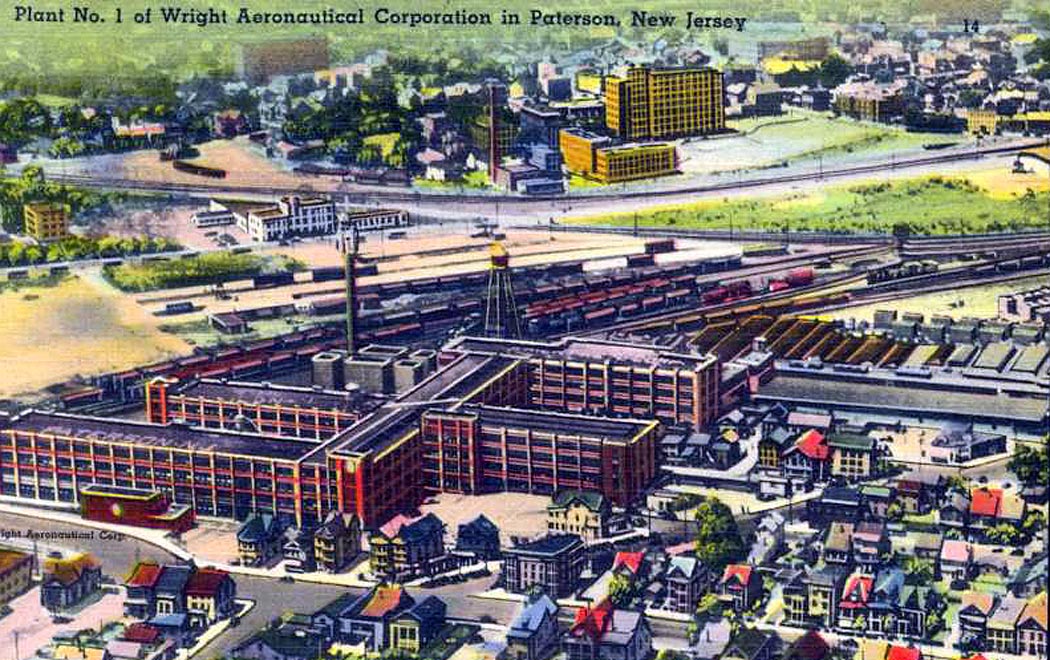
Architectural Context, Integrity & Significance
The Wright Aeronautical Corporation is an expansive historic industrial complex developed beginning in about 1916, with a number of expansion and site development episodes until about 1948 when operations in Paterson were decommissioned and the properties sold. The selected properties included this historic designation process in total compose an approx. 6.7-acre contiguous site bounded by Beckwith Ave., the Conrail (Erie Lackawanna) railroad tracks, and Lindbergh Place. Currently, four ownership entities are represented in these parcels containing contiguous industrial structures of similar architectural design and materials, representing the earliest site development episode of the Wright complex. These impressive structures are excellent examples of early twentieth-century progressive steel and concrete mill construction in their materials, design, massing and utilitarian styling.
The
development of the Wright complex was begun by the Paterson Industrial
Development Company circa 1916-20 with the construction of a four story
building at 238 Lindbergh Place (formerly Lewis Street). Prominent Paterson
architect Fred W. Wentworth designed this building in the new modern
International style of the time, utilizing a reinforced concrete frame
construction with brick curtain walls, and large, steel frame windows spanning
the wide bays. Today, some ornamental detail remains at the cornice,
particularly at the corners of the building. This building was the first to be
occupied by the Wright Aeronautical Corporation
upon their arrival in Paterson in 1920 (under lease from the Paterson
Industrial Development Company).
The complex was considerably
expanded by Wright from the late 1920s through the first years of the 1940s,
and it now overall comprises seven primary structures and associated additions
arranged in a domino-like plan along the northeastern side of the railroad
tracks. Wright's initial program of expansion was completed during the late
1920s and was primarily at the southern end of the site of which this
designation is focused on. The Wright buildings constructed at this time were
designed to look much like the original building at 238 Lindbergh Place, but
with even less ornamental detail. The new structures were typically four
stories in height and were of reinforced concrete construction. At present,
most windows have been removed and filled with concrete block, and the
buildings now support a variety of small industries and warehousing businesses.
With respect to integrity of the Wright Aeronautical Corp. complex overall, very good integrity is clearly evident in the comparison of current conditions with historic maps and photographs with respect to the complex's historic massing and site features. The site is in very good repair and occupied under a light industrial/commercial tenant reuse plan. Consistent with the general trend in reuse interest in complexes of this character across the region and in Paterson since the decline and closing of the textile trades especially post-war, the complex experienced physical changes over the last several decades. While many moderate, inappropriate reversible and non-reversible changes were made to some of the building's entrances and fenestration over the years to accommodate reuse, it retains a high degree of its historic integrity since it has "not been seriously disfigured or compromised [at the time of consideration] by irreversible and inappropriate alterations." Overall, given the mills' scale, architectural qualities and feeling of historic association, including its setting, are not overwhelmed by the alterations made to date.
Historic significance, context & association
In 1920, the Wright
Aeronautical Corporation leased space within an industrial building built by
the Paterson Industrial Development Company and designed by prominent Paterson
architect F.W. Wentworth on the northeast side of the Erie line a short
distance to the northwest of Madison Avenue. Wright was formed through a
reorganization of the Wright-Martin Aircraft Corporation in 1919 and traced its
corporate roots to the concern formed by Orville and Wilbur Wright in 1909. The
company was recovering from a loss of business following the end of the First
World War and relocated their operations to Paterson from New Brunswick. Their
business accelerated quickly with the addition of Charles F. Lawrence, a leader
in the field of air-cooled aircraft engine technology, to their management
staff, and Wright began to expand their facilities. The successful development
of the Whirlwind engine by Lawrence and the Wright Corporation allowed for the
procurement of Navy contracts for the production of these engines.
In 1926, Wright began production of its improved Whirlwind J-5 engine for both military and domestic aircraft. The success of this engine is credited as a major factor in promoting the large-scale development of the international aviation industry and brought Wright to a position of prominence within that industry. Charles Lindbergh's Spirit of St. Louis was powered by a Wright Whirlwind J-5 engine, as were record-breaking aircraft flown by such noted aviators as Richard Byrd, Floyd Bennett, Clarence Chamberlain, Charles Levine, and Amelia Earhart. Wright's success supported a significant expansion of their plant on the northeast side of the Erie line between 1927 and 1929, and the company also acquired and redeveloped the dormant (since 1926) former American Locomotive Corporation Cooke Works on the southwest side of the railroad in 1928.
 The Curtiss-Wright
Corporation was formed through the merger of the Curtiss Aeroplane and Motor
Company, the Wright Aeronautical Corporation, and several smaller concerns in
1929. From that time on the Wright Aeronautical Corporation functioned as a
subsidiary of Curtiss-Wright. It was also in 1929 that Wright sold the front
section of the former Cooke Works back to the American Locomotive Company, who
in turn immediately conveyed the property to the Morrison Machine Company, a
producer of dyeing and finishing machinery for the silk industry. By 1932, the
Wright operation in Paterson was described as the largest of its kind in the
world. The company employed over 2,400 workers, and produced the Whirlwind and
the more powerful Cyclone engines for both domestic and foreign markets. No
doubt this contributed to the Paterson facility's description as "the
largest airplane engine factory in the United States" by the Federal Writers'
Project in 1939.
The Curtiss-Wright
Corporation was formed through the merger of the Curtiss Aeroplane and Motor
Company, the Wright Aeronautical Corporation, and several smaller concerns in
1929. From that time on the Wright Aeronautical Corporation functioned as a
subsidiary of Curtiss-Wright. It was also in 1929 that Wright sold the front
section of the former Cooke Works back to the American Locomotive Company, who
in turn immediately conveyed the property to the Morrison Machine Company, a
producer of dyeing and finishing machinery for the silk industry. By 1932, the
Wright operation in Paterson was described as the largest of its kind in the
world. The company employed over 2,400 workers, and produced the Whirlwind and
the more powerful Cyclone engines for both domestic and foreign markets. No
doubt this contributed to the Paterson facility's description as "the
largest airplane engine factory in the United States" by the Federal Writers'
Project in 1939.The greatly increased
demand for aircraft engines created by the Second World War triggered the final
major expansion of the Paterson facilities of the Wright Aeronautical
Corporation during the early years of the war. The former Cooke Locomotive
Works property on the east side of Madison Ave. was almost entirely redeveloped
during the early 1940s with Wright building a single, huge industrial structure
comprising 2.3 million square feet of floor space. Wright also expanded its
complex on the opposite side of the rail line through the construction of a
major addition at the northern end to provide additional manufacturing and
warehousing space as well as a new testing facility. Wright engines powered all
of the B-17 Flying Fortresses utilized during the war, along with the B-25
bombers that participated in the Doolittle raid on Tokyo in 1942 and the Enola
Gay, the B-29 Superfortress that dropped the atomic bomb on Hiroshima on August
6, 1945.
Despite the company's considerable success during the first half of the century, with the reduction in demand that followed the end of the Second World War the Wright Aeronautical Corporation dramatically reduced their operations. The Paterson facility was shut down, with attention shifting fully to a new facility in Wood-Ridge that was built during the war. Wright sold off both of its properties along Madison Avenue in 1947. The former Cooke Locomotive Works property was conveyed to the Continental Can Company in 1948 (with the northern end of the complex retained by the Morrison Machine Company), while by 1951 the large Wright complex on the opposite side of the railroad was the property of Webb & Knapp, Inc.
References
Guzzo, Dorothy P. "Cooke Locomotive & Machine Co./American Locomotive Co./ Wright Aeronautical Co. Historic District SHPO Opinion," 1998.
The RBA Group, "Reconnaissance-/Intensive Level Historic Architectural Survey, Madison Avenue/Conrail Bridge Replacement Project, City of Paterson, Passaic County, New Jersey," 1998.
The Paterson Press Guardian, "Paterson in Pictures," 1923.
Mingos, Howard. The Aircraft Year Book for 1938, 1938.
Passaic County Historical Society, "Curtis-Wright Collection."
Department of Community Development, "City of Paterson Survey," 1987.
Archimede, Gianfranco, "Paterson Historic Mills Group Municipal Historic Site Designations Staff Opinion of Eligibility," 2012.
Hyde, E. B. Atlas of Passaic County, New Jersey, 1877.
Robison, E. Atlas of the City of Paterson, New Jersey, 1884.
Robinson, E. Atlas of the City of Paterson and Haledon New Jersey, 1899.
Mueller, A. H. Atlas of the City of Paterson, New Jersey, 1915.
Sanborn Map Company Insurance, Maps of Paterson, New Jersey, 1915.
Sanborn Map Company Insurance, Maps of Paterson, New Jersey, 1931.
Sanborn Map Company Insurance, Maps of Paterson, New Jersey, 1950.